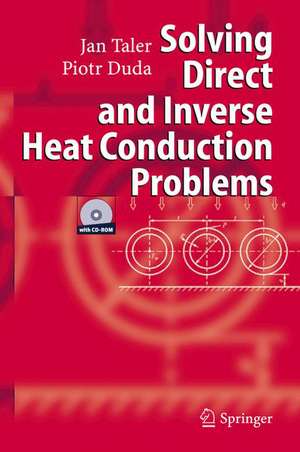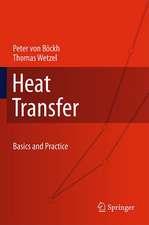Solving Direct and Inverse Heat Conduction Problems
Autor Jan Taler, Piotr Dudaen Limba Engleză Hardback – 18 oct 2006
| Toate formatele și edițiile | Preț | Express |
|---|---|---|
| Paperback (1) | 1246.15 lei 6-8 săpt. | |
| Springer Berlin, Heidelberg – 29 oct 2016 | 1246.15 lei 6-8 săpt. | |
| Hardback (1) | 1250.56 lei 6-8 săpt. | |
| Springer Berlin, Heidelberg – 18 oct 2006 | 1250.56 lei 6-8 săpt. |
Preț: 1250.56 lei
Preț vechi: 1525.07 lei
-18% Nou
Puncte Express: 1876
Preț estimativ în valută:
239.30€ • 250.48$ • 199.17£
239.30€ • 250.48$ • 199.17£
Carte tipărită la comandă
Livrare economică 31 martie-14 aprilie
Preluare comenzi: 021 569.72.76
Specificații
ISBN-13: 9783540334705
ISBN-10: 354033470X
Pagini: 920
Ilustrații: XXVI, 889 p.
Dimensiuni: 155 x 235 x 54 mm
Greutate: 1.39 kg
Ediția:2006
Editura: Springer Berlin, Heidelberg
Colecția Springer
Locul publicării:Berlin, Heidelberg, Germany
ISBN-10: 354033470X
Pagini: 920
Ilustrații: XXVI, 889 p.
Dimensiuni: 155 x 235 x 54 mm
Greutate: 1.39 kg
Ediția:2006
Editura: Springer Berlin, Heidelberg
Colecția Springer
Locul publicării:Berlin, Heidelberg, Germany
Public țintă
ResearchCuprins
Heat Conduction Fundamentals.- Fourier Law.- Mass and Energy Balance Equations.- The Reduction of Transient Heat Conduction Equations and Boundary Conditions.- Substituting Heat Conduction Equation by Two-Equations System.- Variable Change.- Exercises. Solving Heat Conduction Problems.- Heat Transfer Fundamentals.- Two-Dimensional Steady-State Heat Conduction. Analytical Solutions.- Analytical Approximation Methods. Integral Heat Balance Method.- Two-Dimensional Steady-State Heat Conduction. Graphical Method.- Two-Dimensional Steady-State Problems. The Shape Coefficient.- Solving Steady-State Heat Conduction Problems by Means of Numerical Methods.- Finite Element Balance Method and Boundary Element Method.- Transient Heat Exchange between a Body with Lumped Thermal Capacity and Its Surroundings.- Transient Heat Conduction in Half-Space.- Transient Heat Conduction in Simple-Shape Elements.- Superposition Method in One-Dimensional Transient Heat Conduction Problems.- Transient Heat Conduction in a Semi-Infinite Body. The Inverse Problem.- Inverse Transient Heat Conduction Problems.- Multidimensional Problems. The Superposition Method.- Approximate Analytical Methods for Solving Transient Heat Conduction Problems.- Finite Difference Method.- Solving Transient Heat Conduction Problems by Means of Finite Element Method (FEM).- Numerical-Analytical Methods.- Solving Inverse Heat Conduction Problems by Means of Numerical Methods.- Heat Sources.- Melting and Solidification (Freezing).
Recenzii
From the reviews:
"The present book is devoted to direct and inverse heat conduction problems. … The methods for solving problems involved with welding and laser technology are also discussed in great detail. The present book is addressed to undergraduate and PhD students of mechanical, power, process and environment engineering. … it can also serve as a reference book to be used by nuclear, industrial and civil engineers." (Lubomira Softova, Zentralblatt MATH, Vol. 1122 (24), 2007)
"The present book is devoted to direct and inverse heat conduction problems. … The methods for solving problems involved with welding and laser technology are also discussed in great detail. The present book is addressed to undergraduate and PhD students of mechanical, power, process and environment engineering. … it can also serve as a reference book to be used by nuclear, industrial and civil engineers." (Lubomira Softova, Zentralblatt MATH, Vol. 1122 (24), 2007)
Notă biografică
Professor Jan Taler is a director of the Department of Process and Power Engineering at the Faculty of Mechanical Engineering, Krakow University of Technology. He has lectures on heat transfer processes and thermal power plants at the Faculty of Mechanical Engineering and the Faculty of Computer and Electrical Engineering. His research interests mainly lie in heat transfer, inverse heat conduction problems and monitoring of thermal stresses, which arise during the operations of energy installations and machinery. The results of his research on heat transfer, thermal stresses, optimum heating and cooling of solids and measuring of heat flux were published in well-known international journals, such as Transactions of the ASME, International Journal of Heat and Mass Transfer, Heat and Mass Transfer, Forschung im Ingenieurwessen, Brennstoff-Warme-Kraft, VGB Kraftwerkstechnik and VGB Power Tech.
Professor Taler was a research fellow of DAAD in Germany and of Alexander von Humboldt Foundation at the University of Stuttgart. He is also a member of the Committee of Combustion and Thermodynamics at the Polish Academy of Sciences. He is also the author of over 200 publications and 5 monographies, including three in German language. He has received Siemens Award for his achievements in scientific research, the Award of the Minister of Education and the Award of the Rector of the Krakow University of Technology.
Dr. Piotr Duda is an associate professor at the Department of Process and Power Engineering of the Faculty of Mechanical Engineering, Krakow University of Technology. Between 1997-1998, he was a research fellow at the Swiss Federal Institute of Technology in Lausanne (EPFL). Between 2002-2003, he was a research fellow of the Alexander von Humboldt Foundation at the University of Stuttgart, Germany. He has published over 50 articles on heat transfer problems, thermal stresses and numerical methods both at homeand abroad.
Professor Taler was a research fellow of DAAD in Germany and of Alexander von Humboldt Foundation at the University of Stuttgart. He is also a member of the Committee of Combustion and Thermodynamics at the Polish Academy of Sciences. He is also the author of over 200 publications and 5 monographies, including three in German language. He has received Siemens Award for his achievements in scientific research, the Award of the Minister of Education and the Award of the Rector of the Krakow University of Technology.
Dr. Piotr Duda is an associate professor at the Department of Process and Power Engineering of the Faculty of Mechanical Engineering, Krakow University of Technology. Between 1997-1998, he was a research fellow at the Swiss Federal Institute of Technology in Lausanne (EPFL). Between 2002-2003, he was a research fellow of the Alexander von Humboldt Foundation at the University of Stuttgart, Germany. He has published over 50 articles on heat transfer problems, thermal stresses and numerical methods both at homeand abroad.
Textul de pe ultima copertă
The book presents a solution for direct and inverse heat conduction problems. In the first part, the authors discuss the theoretical basis for the heat transfer process. In the second part, they present selected theoretical and numerical problems in the form of exercises with their subsequent solutions. Such layout of the book will allow the reader to become more familiar with step-by-step calculation methods and with the practical application of the equations to the solution of design and utilization problems of thermal machinery. It will also help to master complex mathematics behind the heat transfer theory.
The book covers one-, two- and three dimensional problems which are solved by using exact and approximate analytical methods and numerical methods such as: the finite difference method, the finite volume method, the finite element method and the boundary method. Unlike other books on the subject, the superposition method is thoroughly presented. Particular attention is paid to the solution of inverse heat conduction problems.
The authors took special care that the solved inverse problems can be implemented in indirect measurements of boundary heat flux and heat transfer coefficient. Included in this text is the determination of optimal fluid temperature changes during heating and cooling of solids. In great detail the problems of temperature transients caused by both moveable and immovable heat sources is discussed. They analyze the melting and freezing processes, including the freezing of food products. Moreover, they use computing programs written in Fortran language for solving mathematical equations. The book content is strengthened by additional materials presented at the back of the book, which include, among others, the description of basic mathematical functions characteristic of heat transfer problems, calculation of the inverse Laplace transformation, the property tables for stable thermophysical bodies and shape coefficients for isothermal surfaces of various shapes and programs that are typically used for solving differential equations. This book is strongly recommended for undergraduate and PhD students, researchers and academics of Power, Process, Mechanical and Environmental Engineering Faculties. The book should also appeal to those who conduct research in the area of thermal engineering, house-heating, air-conditioning systems and cooling processes, combustion engines and welding technology.
The book covers one-, two- and three dimensional problems which are solved by using exact and approximate analytical methods and numerical methods such as: the finite difference method, the finite volume method, the finite element method and the boundary method. Unlike other books on the subject, the superposition method is thoroughly presented. Particular attention is paid to the solution of inverse heat conduction problems.
The authors took special care that the solved inverse problems can be implemented in indirect measurements of boundary heat flux and heat transfer coefficient. Included in this text is the determination of optimal fluid temperature changes during heating and cooling of solids. In great detail the problems of temperature transients caused by both moveable and immovable heat sources is discussed. They analyze the melting and freezing processes, including the freezing of food products. Moreover, they use computing programs written in Fortran language for solving mathematical equations. The book content is strengthened by additional materials presented at the back of the book, which include, among others, the description of basic mathematical functions characteristic of heat transfer problems, calculation of the inverse Laplace transformation, the property tables for stable thermophysical bodies and shape coefficients for isothermal surfaces of various shapes and programs that are typically used for solving differential equations. This book is strongly recommended for undergraduate and PhD students, researchers and academics of Power, Process, Mechanical and Environmental Engineering Faculties. The book should also appeal to those who conduct research in the area of thermal engineering, house-heating, air-conditioning systems and cooling processes, combustion engines and welding technology.
Caracteristici
Presents the theoretical basis for thermal conduction in solids, motionless liquids and liquids that move Includes a multitude of solved examples and solutions of engineering heat conduction problems, for example during the designing and life-time calculations of industrial machinery, combustion engines and in refrigerating and air conditioning engineering User-oriented written, easy to follow Makes the reader in a step-by-step fashion acquainted with all the mathematical derivations and solutions to the significant transient and steady-state heat conduction problems Accompanying CD-Rom includes computational solutions of the examples/FORTRAN codes












